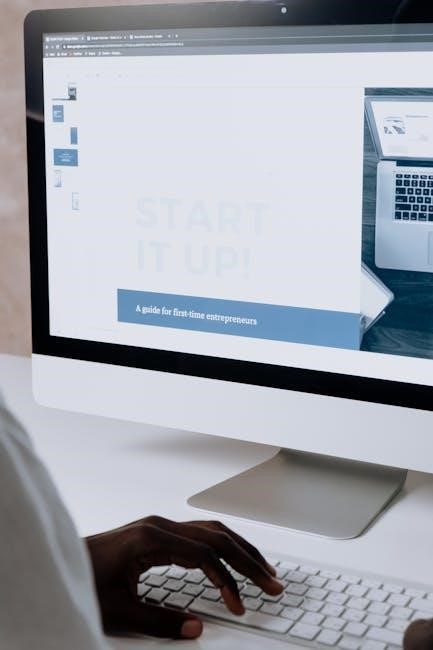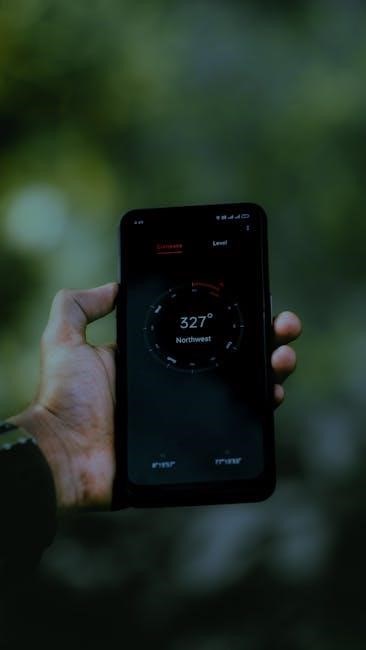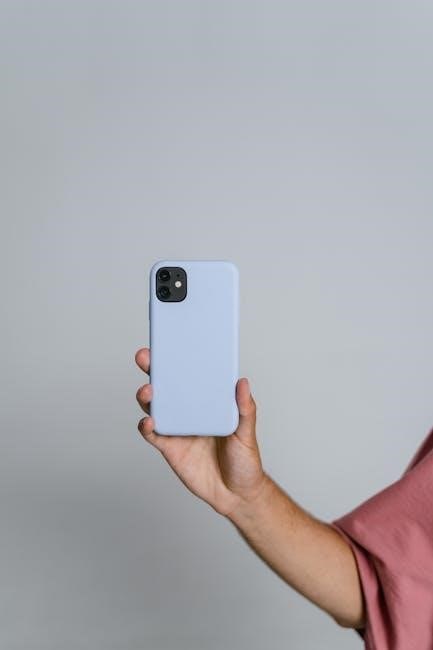Product Overview
The Contour Next One blood glucose meter is a Bluetooth-enabled, easy-to-use device designed for seamless diabetes management. It connects to the Contour Diabetes app, offering accurate results and comprehensive tracking features for better health monitoring.
1.1. Key Features of the Contour Next One Blood Glucose Meter
The Contour Next One blood glucose meter is a Bluetooth-enabled device designed for seamless connectivity with the Contour Diabetes app. It offers quick results in just 5 seconds, requiring only a small blood sample. The meter features a backlit display for easy readability, meal marking, and event tagging to track glucose levels in relation to daily activities. Its user-friendly design and advanced features make it an ideal choice for effective diabetes management and data tracking.
1.2. Design and Portability
The Contour Next One blood glucose meter features a sleek, compact design that prioritizes portability and ease of use. Its lightweight and ergonomic build makes it easy to carry in a pocket or bag, ensuring convenient blood glucose monitoring on the go. The meter’s intuitive interface and backlit display enhance readability, while its durable construction withstands daily use; Designed for discretion and accessibility, the Contour Next One is tailored for individuals managing diabetes with an active lifestyle.
1.3. Compatibility with the Contour Diabetes App
The Contour Next One meter seamlessly connects to the Contour Diabetes App via Bluetooth, enabling real-time synchronization of blood glucose data. This integration allows users to track their readings, set reminders, and analyze trends effortlessly. The app supports features like meal marking and event tagging, providing a comprehensive view of glucose levels in relation to daily activities. Compatibility ensures enhanced data management and personalized insights, making diabetes management more intuitive and effective.

Getting Started
Unboxing and setting up the Contour Next One is straightforward. After checking components and inserting the battery, set the date and time to begin using the meter easily.
2.1. Unboxing and Initial Setup
When unboxing the Contour Next One, ensure all components are included: the meter, test strips, lancing device, lancets, control solution, and user guide. Carefully inspect each item for damage. Before using, charge the meter if necessary and ensure the battery is correctly inserted. Read the user guide thoroughly to familiarize yourself with the device’s features and operation. Proper setup ensures accurate readings and optimal performance for effective diabetes management.
2.2. Checking the Meter and Components
Upon unboxing, carefully inspect the Contour Next One meter and its components for any visible damage or wear. Ensure all items are included, such as the meter, test strips, lancing device, lancets, and control solution. Verify the meter’s screen is intact and functional. Check the test strip vial for any signs of tampering or expiration. Examine the lancing device and lancets for proper condition. If any component is damaged or missing, contact customer support immediately to avoid inaccurate readings or device malfunctions.
2.3. Inserting the Battery
To power your Contour Next One meter, insert a new lithium battery (CR2032) into the battery compartment. Locate the compartment on the back of the meter and slide it open. Insert the battery with the positive (+) side facing upwards. Ensure it is securely placed to avoid any loose connections. Close the compartment firmly until it clicks. Turn the meter on to confirm it powers up correctly. If the screen remains off, check the battery orientation and ensure the compartment is properly closed. Refer to the user manual for diagrams or additional guidance.
2.4. Setting the Date and Time
Setting the correct date and time on your Contour Next One meter is essential for accurate blood glucose record-keeping. Navigate to the settings menu using the navigation buttons. Use the up/down arrows to scroll through options and select the date and time function. Enter the current date (MM/DD/YYYY) and time (HH:MM) using the numeric keypad. Ensure the time format matches your preference (12/24-hour). Save your settings by pressing the confirm button. The meter will now display the correct date and time, ensuring all readings are timestamped accurately for proper tracking and management. Always verify the accuracy of these settings before testing to maintain reliable data records. If the date or time is incorrect, repeat the process to update them. This step is crucial for syncing data with the Contour Diabetes app and maintaining consistent records. If you encounter any issues, refer to the troubleshooting section or contact customer support for assistance. Properly set date and time ensure seamless integration with other features and accurate historical data analysis, which is vital for effective diabetes management. By following these steps, you can ensure your meter is correctly configured and ready for use. Regularly check and update the date and time, especially after battery replacements or extended periods of inactivity, to prevent data discrepancies. This simple process helps maintain the integrity of your blood glucose records and supports better decision-making for your diabetes care routine.
Basic Operation
Turn on the meter, insert a test strip, and code the device as instructed. Take a blood sample, apply it to the strip, and wait for accurate results.
3.1. Turning On the Meter
To turn on the Contour Next One blood glucose meter, ensure the battery is correctly inserted. The meter will automatically power on when the battery is installed. If it does not turn on, press and hold the power button until the display lights up. Check for any error messages or low battery alerts. Once on, the meter is ready for use. Ensure all components are functioning properly before proceeding with a test. Follow the on-screen instructions for a smooth start.

3.2. Using Test Strips
Insert a Contour Next One test strip into the meter’s test strip port, ensuring it clicks into place. The meter will automatically turn on. Gently touch the test strip tip to a blood sample, ensuring the strip is filled correctly. The meter will analyze the sample and display your blood glucose level. Always use unexpired, undamaged strips for accurate results. If an error occurs, refer to the user guide or contact support for assistance.
3.3. Coding the Meter
Coding the Contour Next One meter ensures compatibility with the test strips. Insert a test strip into the port, and the meter will automatically activate. Follow the on-screen instructions to complete the coding process. Ensure the code matches the test strip batch to maintain accuracy. The meter is pre-coded for convenience, but always verify with the provided code label. Proper coding is essential for reliable results; If issues arise, refer to the user guide or contact support for further assistance.
3.4; Taking a Blood Sample
To take a blood sample, wash your hands thoroughly and prepare the lancing device. Choose a clean fingertip, avoiding the tip to minimize pain. Use a new lancet each time to ensure hygiene and safety. Gently press the lancing device against your skin until a small blood drop forms. Avoid squeezing too much, as this can affect accuracy. Allow the blood drop to fall onto the test strip, ensuring proper placement for an accurate reading. Follow the meter’s instructions for correct application.
3.5. Reading and Interpreting Results
The Contour Next One meter provides accurate blood glucose readings in just 5 seconds. The result will appear on the display, and the meter may include indicators such as arrows or color coding to indicate if your reading is high, low, or within your target range. Understanding these indicators helps you make informed decisions about your diabetes management. Always refer to your healthcare provider’s guidelines for interpreting results and adjusting your treatment plan accordingly. Use the Contour Diabetes app to track trends and set reminders for monitoring.

Advanced Features

The Contour Next One offers Bluetooth connectivity for real-time syncing with the Contour Diabetes app, enabling meal marking, event tagging, and comprehensive data storage for enhanced monitoring.
4.1. Bluetooth Connectivity and Syncing with the App
The Contour Next One blood glucose meter features Bluetooth connectivity, allowing seamless syncing with the Contour Diabetes app. This feature enables users to automatically transfer blood glucose readings to their smartphone, providing real-time tracking and analysis. The app stores data, offers customizable reports, and allows for easy sharing with healthcare providers. Bluetooth pairing is straightforward, ensuring a reliable connection and enhancing the overall diabetes management experience with convenience and efficiency.
4.2. Meal Marking and Event Tagging
The Contour Next One allows users to mark meals and tag events, enhancing blood glucose tracking. Meal marking helps identify how different foods affect blood sugar levels, while event tagging enables users to note activities like exercise or stress. These features provide context to blood glucose data, making it easier to understand patterns and manage diabetes effectively. The Contour Diabetes app supports editing and adding these markers, offering a comprehensive overview of daily activities and their impact on health.
4.3. Data Storage and Retrieval
The Contour Next One stores up to 1,000 blood glucose readings, allowing users to track their data over time. The meter organizes results by date and time, making it easy to review historical data. The Contour Diabetes app syncs with the meter, enabling users to access and manage their data on their smartphone. Stored data can be filtered by specific periods, and detailed reports can be generated for better understanding of glucose trends. This feature enhances monitoring and supports informed decision-making for effective diabetes management.

Using the Contour Diabetes App
The Contour Diabetes app seamlessly connects with your meter, allowing you to track, analyze, and manage blood glucose data. It offers features like meal marking, event tagging, and customizable alerts to support your diabetes management journey effectively.
5.1. Downloading and Installing the App
To start using the Contour Diabetes app, download it from the Google Play Store or Apple App Store. Once installed, open the app and follow the on-screen instructions to complete the setup. The app is free and designed to be user-friendly, ensuring a smooth experience for managing your blood glucose data. It integrates seamlessly with your Contour Next One meter, allowing you to track your readings, set reminders, and access detailed reports to help you make informed decisions about your diabetes care.
5.2. Pairing the Meter with the App
To pair the Contour Next One meter with the app, ensure Bluetooth is enabled on your meter. Open the Contour Diabetes app, navigate to the menu, and select “Pair Meter.” Follow the on-screen instructions to complete the pairing process. Once connected, your blood glucose readings will automatically sync to the app, allowing you to view and manage your data effortlessly. This seamless connection enhances your diabetes management experience.
5;3. Viewing and Managing Blood Glucose Data
The Contour Diabetes app allows you to easily view and manage your blood glucose data. Your readings are automatically synced from the meter and displayed in a clear, graphical format. You can filter data by date or time and add notes or tags to specific readings for better tracking. The app also provides insights and summaries of your glucose levels, helping you identify trends and patterns. This feature-rich interface makes it simple to monitor your progress and share data with healthcare professionals.
5.4. Setting Reminders and Alerts
The Contour Diabetes app enables you to set customizable reminders and alerts to help manage your diabetes routine. You can schedule reminders for blood glucose testing, medication times, or meal intervals. Alerts can be set for high or low glucose levels, ensuring timely actions. These features promote consistent monitoring and proactive health management, helping you stay on track with your diabetes care plan. Customize these settings to fit your lifestyle and needs for better adherence to your treatment regimen.

Accuracy and Control
This section emphasizes ensuring precise blood glucose readings. Use control solutions to verify meter accuracy and perform regular quality checks to maintain reliable results and proper device function.
6.1. Using Control Solutions
To ensure accuracy, use CONTOUR NEXT control solutions. These aqueous glucose solutions are designed for quality control checks. Apply a control solution to a test strip, insert it into the meter, and compare the result with the expected range printed on the solution bottle. If results are outside the range, refer to the user manual for troubleshooting or contact technical support. Regular control checks help maintain accurate readings and proper device function. Always follow the instructions provided for best results.
6.2. Performing a Quality Control Check
A quality control check ensures your meter and test strips are functioning correctly. Start by turning on the meter and preparing a control solution. Dip a test strip into the solution, then insert it into the meter. The result should match the expected range on the solution bottle. If it doesn’t, recalibrate or replace the strip. Repeat if necessary. Regular checks help verify accuracy and reliability, ensuring your readings are trustworthy. Follow the user guide for detailed steps and troubleshooting tips.
6.3. Troubleshooting Common Errors
Common errors with the Contour Next One may include incorrect test strip insertion or expired strips. Ensure strips are unused and within their expiration date. If the meter displays an error code, refer to the user guide for specific solutions. For connectivity issues, restart the meter and app, or check Bluetooth settings. If problems persist, perform a quality control check or contact technical support. Regular maintenance and updates can help prevent errors and ensure accurate readings.

Maintenance and Care
Regular cleaning, proper storage, and battery replacement ensure optimal performance. Follow guidelines for handling test strips and meter care to maintain accuracy and longevity.
7.1. Cleaning the Meter
Regular cleaning of the Contour Next One Blood Glucose Meter is essential for maintaining accuracy and longevity. Use a soft, dry cloth to wipe the exterior. For more thorough cleaning, dampen the cloth with mild soap and water, but avoid harsh chemicals or immersing the device. Ensure the meter is dry before use to prevent damage. Cleaning helps remove dirt or residue that may affect performance. Always follow the user manual’s guidelines for proper care and maintenance.
7.2. Replacing the Battery
To replace the battery in your Contour Next One meter, first turn it off. Open the battery compartment, usually found on the back or bottom. Remove the old battery and dispose of it properly. Insert a new CR2032 lithium battery, ensuring the positive side faces up. Close the compartment securely. Turn the meter back on and check its operation. Use only the recommended battery type to maintain functionality and avoid damage.
7.3. Storing the Meter and Test Strips
Store the Contour Next One meter in a cool, dry place, away from direct sunlight. Avoid extreme temperatures and humidity. Keep test strips in their original container, tightly sealed, to maintain accuracy. Do not expose strips to moisture or heat. Regularly check the expiration date on the test strip vial. For optimal performance, store the meter and strips in their protective cases when not in use. Ensure all components are clean and dry before storage to prevent damage or contamination.

Frequently Asked Questions
This section addresses common queries about the Contour Next One, such as connectivity issues, test strip usage, and data syncing, ensuring smooth device operation and troubleshooting.
8.1. Common User Queries
Users often ask about syncing issues, test strip accuracy, and error codes. The Contour Next One support team provides troubleshooting guides for connectivity problems and data syncing. Many inquiries focus on app pairing and blood glucose tracking. Tips for resolving common errors, such as incorrect coding or expired strips, are also frequently requested. Additionally, users seek advice on updating software and accessing historical data through the app.

8.2. Technical Support and Resources
For technical assistance, users can access the official Ascensia Diabetes Care website, which offers detailed guides, troubleshooting tips, and FAQs. The Contour Next One user manual provides step-by-step instructions for resolving common issues. Additional resources include video tutorials and customer support contact information. Users can also download the Contour Diabetes app for app-related troubleshooting. Online forums and community support groups are available for shared experiences and advice.
